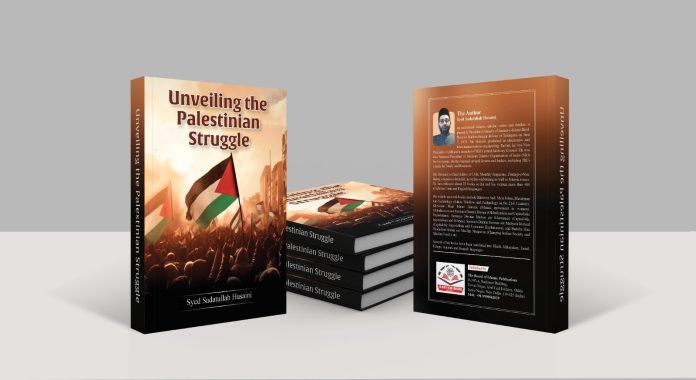Unveiling the Palestinian Struggle
Syed Sadatullah Husaini
The Board of Islamic Publications
2024
– Shayma S
Fresh off the press from The Board of Islamic Publications, Unveiling the Palestinian Struggle is Syed Sadatullah Husaini’s contribution to the current discourse about Palestine. A translation of his editorial (‘Isharaat’) in Zindagi-e-Nau Urdu monthly was ably carried out by Dr Parvez Mandviwala. A note on this review: The work in question is a translation, but this review does not go into the merits of the translation, its accuracy, or its translatability. Therefore, it treats this work as standalone.
A slim booklet of 32 pages, including six pages of extensive references to English and Urdu sources alike, the work offers a quick insight into certain specific aspects of the Palestinian struggle and the Israeli settler-colonial occupation – Zionism and racism; colonialism and expansionism, the ‘Jewish conspiracy’ bubble, and others. Following a foreword by Radiance editor Sikandar Azam, the chapters are ‘Unveiling the Palestinian Struggle’ (an introductory chapter of sorts), ‘Zionism: The Worst Racism of Our Times’; ‘The Zionist Authorities are the Biggest Terrorist Organisation of Our Times’; ‘Colonialism, Expansionism and Neo-settlements’; and ‘The Awe of Power and the ‘Jewish Conspiracy’ Bubble’.
What gets a sense at the outset is that the book is written in a spirit of fortitude, not depression. In a sense, it is framed around the question of the Palestinian Resistance, what the author sees as a modern manifestation of a Furqan (a criterion or standard to judge between right and wrong) mentioned in the holy Qur’an (Surah an-Anfal, 29).
The author establishes right at the beginning that the Palestinian struggle for independence has become a Furqan for our era. The Resistance has exposed the fallacies and façade of Western powers and the Zionist authorities, and Palestinians have also become a barrier between the evil of these Western powers and the rest of the world. They have, in essence, become saviours of those whom the forces of neo-colonial modernity have oppressed. This Furqan is also a distinguishing force, a mark of where one stands; do we stand with the harbingers of justice or collaborate with their oppressors?
So, to begin with, the author has struck a note where he firmly establishes his point of view beyond merely recording the oppression done on Palestinians to frame their fight for redressal in the domain of international law or recount the uncountable violations against them. This is a refreshing change from many social media debates and writings that skirt around the question of the Resistance, especially from a liberal perspective. The author makes it clear that Palestinians are not just victims of history but are defining it on their terms, even if it comes at a significant cost to them.
Coming to the structure of the book, there are both upsides and some negatives. On the positive front, the short chapters allow a reader to process different aspects of the occupation and Zionist settler-colonialism quickly. A reader may be able to focus on a particular aspect that interests them and use the references to pursue further research on the topic. On the downside – not necessarily a negative, but more of a possibility for a future work – considering the author’s extensive reading on the topic, a more cohesive book on what the Resistance to Zionism means, especially the situation in the Indian context, would be of even greater interest and importance to the local audience. This ought to include a list of abbreviations, a brief timeline of Zionism and Palestinian history, and some more references to Palestinian literature.
However, considering the urgent requirement for English-language intervention in the subject from a writer in the Islamic movement in South Asia, this brief intervention will nevertheless be appreciated. Some minor corrections that need attention in subsequent editions include the correction of the spelling of the Nakba (it is currently translated as Naqba), avoiding the use of the term “Red Indians”, which is now considered inappropriate, and use of better quality pictures (with captions).
Two significant things that need appreciation: first, the care and attention towards citations and referencing, something that is often missing in much of the literature produced in this context, especially in booklets. The author has surveyed both news sources and academic sources, and it adds to the robust nature of an otherwise short text. Secondly, the chapter on the Jewish conspiracy is relevant due to its shift away from old-school conspiracy theories that frame Jews in a biologically essentialist sense and instead show how the Resistance has pierced this bubble of claiming everything to be run by an all-powerful Zionist state. The Zionist state is only powerful because it has the backing of major world powers; in all other senses, it stands fully exposed.




